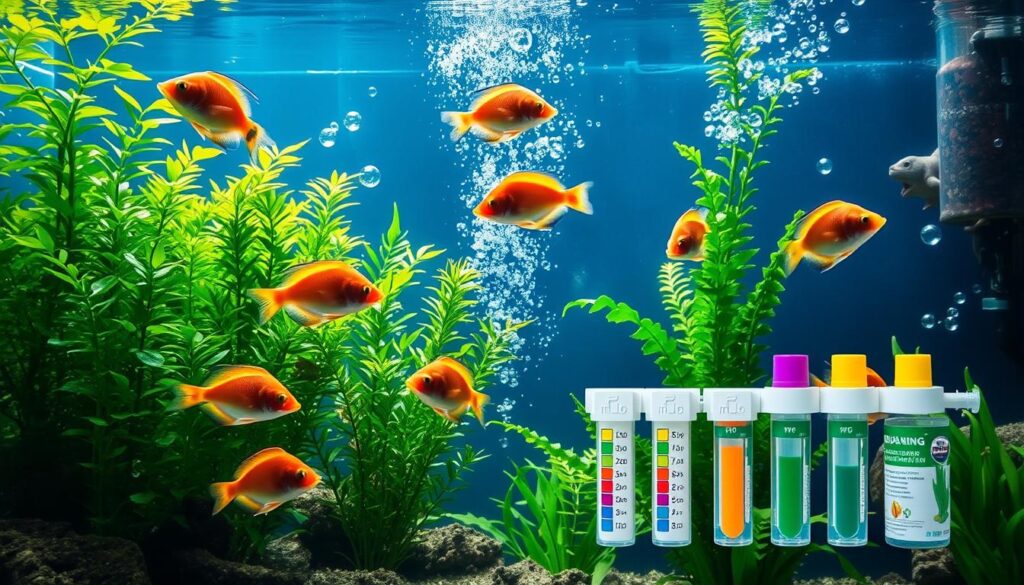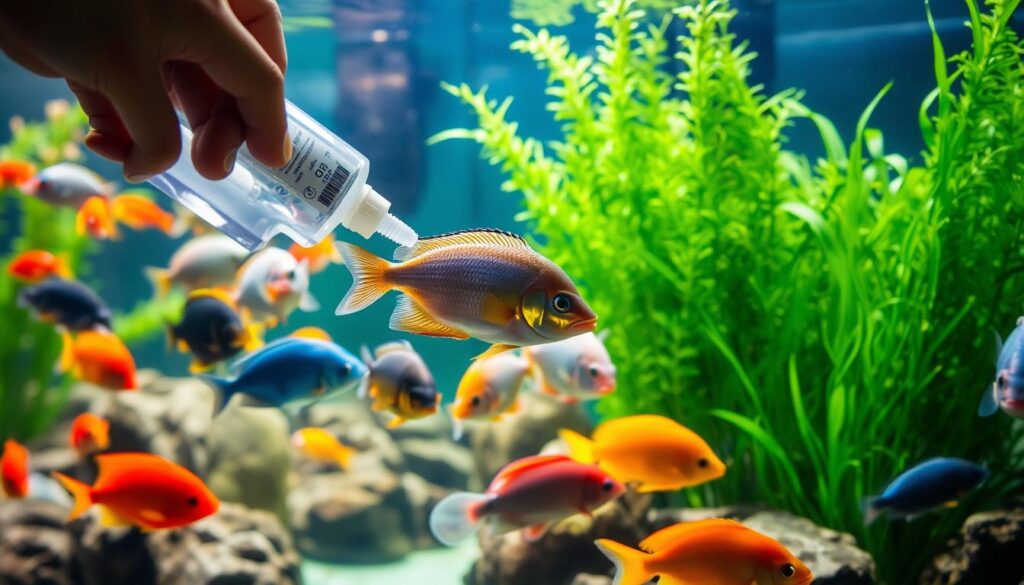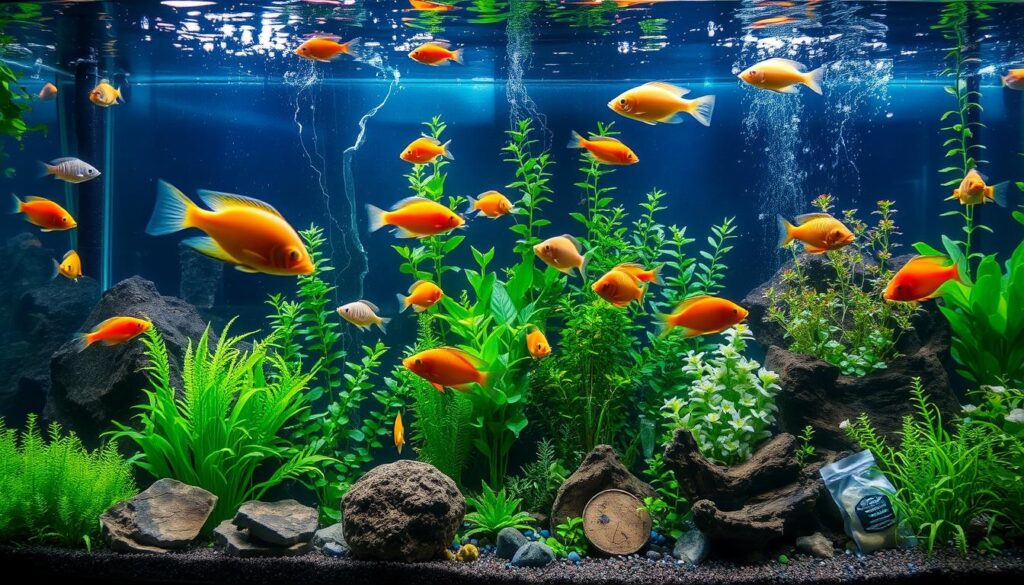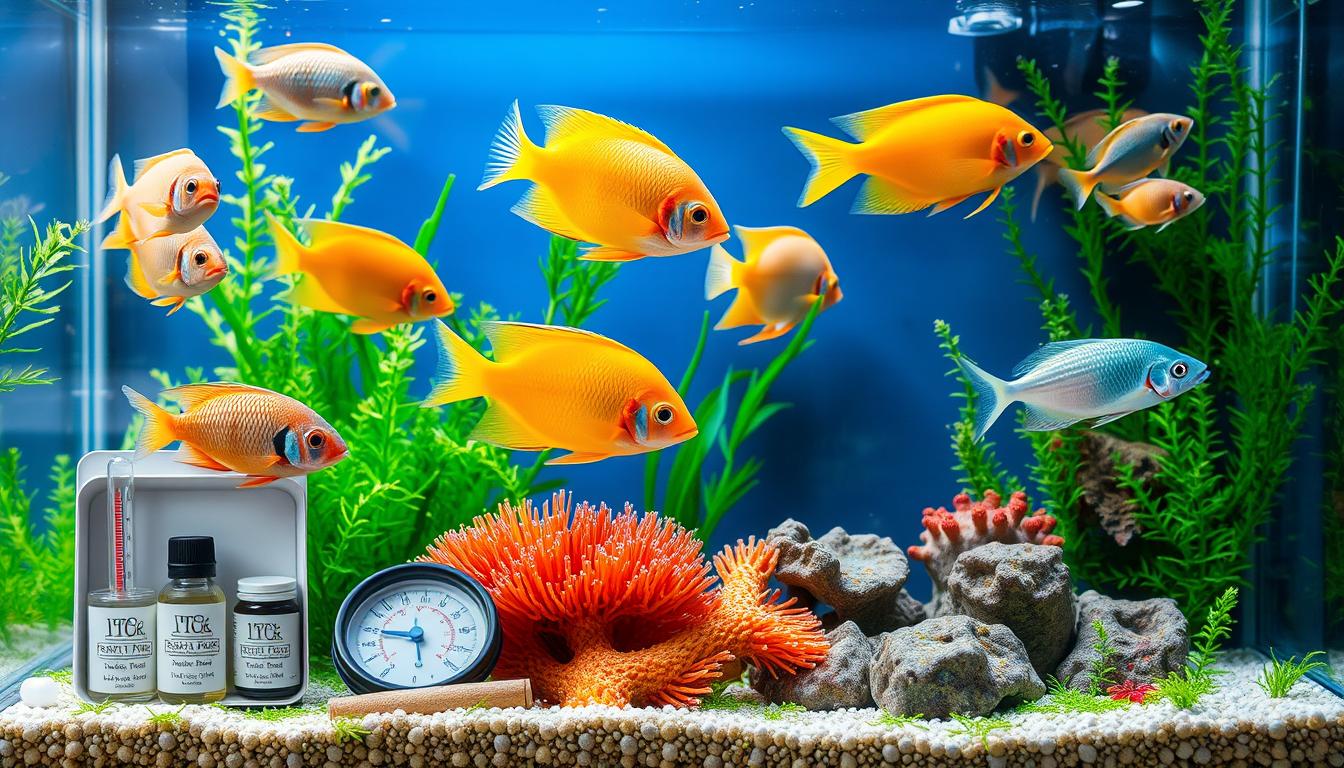Keeping your fish healthy is key for a thriving aquarium. Treating diseases in aquariums is complex. It needs a good grasp of fish disease treatment and water quality.
Effective treatment mixes good water quality, regular care, and knowing common fish illnesses. It’s not just treating diseases. It’s also about stopping them before they start. Early detection and prevention help keep your fish disease-free.
By focusing on aquarium diseases treatment, you can enjoy a stress-free aquarium. With the right knowledge, you can create a healthy home for your fish. This way, they can live long, happy lives.
Key Takeaways
- Regular water quality management is essential for preventing aquarium diseases
- Early detection of fish diseases is critical for effective treatment
- Aquarium diseases treatment requires a comprehensive understanding of fish disease treatment
- Prevention is key to reducing the risk of disease outbreaks
- Proper maintenance and care can help prevent aquarium diseases
- Staying informed about aquarium diseases treatment is crucial for keeping your fish healthy
Understanding the Basics of Aquarium Fish Health
Aquarium health care is key to a thriving aquatic world. Knowing the basics of fish health helps owners prevent diseases. It ensures fish stay healthy and happy. Spotting signs of health and illness is crucial for good care.
Healthy fish are full of color, swim well, and eat a lot. Sick fish breathe hard, move slowly, and look stressed. Stress weakens fish and makes them sick easier.
Signs of a Healthy Fish
- Active and alert behavior
- Vibrant colors and healthy scales
- Strong and steady swimming
- Healthy appetite and digestion
Common Indicators of Illness
- Labored breathing or rapid gill movement
- Lethargy or lack of activity
- Visible signs of stress, such as rapid breathing or erratic swimming
- Changes in appetite or digestion
The Role of Stress in Fish Disease
Stress is a big problem for fish health. It weakens their immune system and makes them sick. By spotting stress signs and reducing it, owners can keep their fish healthy.
Essential Water Parameters for Disease Prevention
Keeping water quality right is key to stopping diseases in aquariums. By watching and keeping water conditions just right, owners can lower disease risks. Regular water testing is key to make sure water is safe for fish.
Important water checks include pH, ammonia, nitrite, and nitrate levels. Proper water quality management stops diseases like fin rot, dropsy, and columnaris. Good water flow and oxygen levels also prevent stress and disease in fish.
- Regularly test the water for pH, ammonia, nitrite, and nitrate levels
- Maintain proper water circulation and oxygenation
- Perform regular water changes to remove waste and excess nutrients
- Monitor the fish for signs of stress or disease and take action promptly
By following these tips and keeping water conditions perfect, owners can stop diseases. Effective water quality management is vital for fish health. It needs constant checking and upkeep to keep water conditions just right.
The Vital Link Between Water Quality and Fish Health
Keeping the water quality right is key to your fish’s health. Bad water can make your fish sick, which is really bad for you as an owner. Knowing how to manage water quality helps keep your fish healthy and happy.
It’s important to check the water often. You need to watch the pH, ammonia, and nitrite levels. Proper pH levels are crucial for your fish’s health. Changes in pH can stress or even kill them. Also, keeping ammonia and nitrite levels low is vital to avoid sickness in your fish.

- Regularly test water parameters
- Maintain proper pH levels
- Manage ammonia and nitrite levels
By doing these things, you can stop your fish from getting sick. Remember, taking care of the water is a constant job. You need to keep checking and fixing things to keep your fish healthy.
Common Types of Aquarium Diseases Treatment Methods
There are many ways to treat fish diseases in aquariums. It’s important to know the causes and the best treatments. Treatments include medicines, natural remedies, and isolating sick fish.
Medication-Based Treatments
Medicines are often used for bacterial and parasitic infections. They can be very effective. But, they should only be used carefully, with advice from a vet or an experienced fish keeper.
Natural Remedies
Changing the water and improving its quality can also help. These steps can reduce stress and keep the fish healthy.
Quarantine Procedures
Quarantining sick fish is key. It stops the disease from spreading and allows for focused treatment.
Knowing about different treatments helps fish owners make the right choices. Whether it’s medicines, natural methods, or quarantine, quick action and a healthy environment are crucial for the fish’s well-being.
Identifying Disease Symptoms in Aquarium Fish
Aquatic pet illnesses can worry aquarium owners a lot. It’s key to spot common fish illnesses early. Look for changes in how they act, look, and feel.
Signs of disease include labored breathing, loss of appetite, and changes in color or appearance. Watching for these signs helps treat fish fast. It keeps the aquarium healthy.
Many diseases come from bad water, stress, and parasites. Knowing this helps prevent illness. Keep water quality good, feed right, and reduce stress. This way, fish stay healthy and happy.
Here are some ways to stop common fish illnesses:
- Regular water testing
- Proper filtration and maintenance
- Quarantine procedures for new fish
- Monitoring fish for symptoms of illness
By taking these steps, owners can keep their fish well. They also stop diseases from spreading.
Bacterial Infections and Their Solutions
Bacterial infections are common in aquariums, often due to poor water quality and stress. When treating fish diseases, knowing the exact infection is key. Understanding the causes and symptoms of various bacterial infections is crucial for effective treatment.
Fin rot, dropsy, and columnaris disease are common bacterial infections in fish. These can be tough to treat, but the right approach can help fish recover. 
Fin Rot Treatment
Fin rot causes the fins of fish to rot away. To treat it, use antibiotics and improve water quality. Regular water changes and a balanced diet can also help prevent the infection’s spread.
Dropsy Management
Dropsy makes fish swell up with fluid. Managing dropsy involves antibiotics and better water quality. It’s also important to ensure fish eat well and reduce stress in the aquarium.
Columnaris Disease Solutions
Columnaris disease causes lesions on fish. To treat it, use antibiotics and improve water quality. Reducing stress and providing a balanced diet can also help prevent the infection’s spread. By understanding these infections and their treatments, aquarium owners can keep their fish healthy and well through effective aquarium diseases treatment.
Treating Parasitic Infestations
Aquatic pet illnesses, like parasitic infestations, stress out aquarium fish. They can cause skin lesions, fin damage, and breathing issues. It’s vital to treat these problems quickly to keep the fish healthy.
There are ways to fight parasitic infestations. Metronidazole is a common medicine used. Natural options like garlic and herbal extracts can work too. Knowing how to treat these issues helps prevent and cure them.
Here are some important steps for treating parasitic infestations:
- Find out what parasite you’re dealing with and how it lives.
- Choose the right treatment, whether it’s medicine or natural remedies.
- Keep the water clean and balanced to stop the problem from coming back.
- Watch the fish closely to see if they’re getting better and change the treatment if needed.
By being proactive and well-informed, aquarium owners can stop the spread of diseases. This helps keep the aquatic environment healthy and thriving.
Regularly checking and caring for the aquarium, along with quick action on parasitic infestations, can stop disease spread. It promotes a balanced and healthy ecosystem.
Fungal Disease Management Strategies
Fungal diseases are common in aquariums. They cause skin lesions, fin damage, and respiratory problems. To treating fish diseases, knowing the causes and treatments is key. Keeping water parameters right and creating a healthy environment for fish helps prevent these diseases.
For effective aquarium diseases treatment, a full plan is needed. This includes regular water changes, good filtration, and a balanced diet for fish. By following these steps and staying up-to-date with new research, owners can stop fungal diseases and keep their fish healthy.
White Spot Treatment
White spot disease is a common fungal infection. It can be treated with medication and good water management. Owners can use over-the-counter meds or see a vet for serious cases.
Cotton Wool Disease Solutions
Cotton wool disease is another fungal infection. It can be treated with medication and better water quality. Regular water changes and good filtration help stop its spread.
Understanding fungal diseases and their treatments helps owners prevent and cure them. Regular care and maintenance are crucial. This makes aquarium diseases treatment more effective and easier.
Preventive Measures for Aquarium Health
Keeping your aquarium clean is key to a healthy home for your fish. A regular cleaning schedule helps avoid diseases. It includes checking water, cleaning the tank, and changing some water.
Feeding your fish right is also important. Too much food can make the water dirty, leading to sickness. Giving them the right food keeps them healthy.
Stress Reduction Techniques
Stress weakens fish, making them sick easier. To keep them calm, add hiding spots and keep the water steady. These steps help keep your fish happy and healthy.
- Regular water testing to monitor water parameters
- Performing partial water changes to maintain good water quality
- Providing a balanced diet that meets the nutritional needs of the fish
- Minimizing stress by providing plenty of hiding places and maintaining a stable water temperature
By taking these steps, you can keep your fish healthy and happy.
Advanced Treatment Protocols for Resistant Diseases
Some fish diseases are hard to treat with regular methods. To tackle these, aquarium owners can use special treatments. This includes combining different therapies and trying new approaches.
Advanced treatment methods for tough diseases include:
- Using a mix of medicines to attack the disease from all sides
- Trying new methods like UV sterilization or ozone therapy
- Improving water quality to lessen fish stress
Knowing these advanced methods helps aquarium owners care for their fish better. It boosts the chances of treating aquarium diseases successfully. Keeping up with the latest treatments is key for the best results.
Dealing with fish diseases means more than just treating them. It’s about keeping water quality high, feeding right, and managing diseases well. By using these advanced protocols and staying informed, owners can make their aquariums a healthy home for fish.
Emergency Care Procedures for Critical Cases
In cases of aquatic pet illnesses, every minute is crucial. Spotting the signs of common fish illnesses early and acting fast can save lives. It’s vital to have a plan for emergency care to prevent further issues.
If your fish shows signs of distress, like labored breathing or erratic swimming, act quickly. Visit online resources to learn about common fish illnesses. Knowing the warning signs and acting fast can stop disease spread and save lives.
Immediate Response Steps
In emergencies, stay calm and follow a clear plan. This might include isolating sick fish, adjusting water, and giving medication. These steps can help stabilize the situation and prevent things from getting worse.
When to Seek Professional Help
While many fish illnesses can be treated at home, some need a vet. If you’re not sure what to do or if the illness doesn’t get better, seek professional help. A vet can give expert advice and create a treatment plan for your fish.
Being ready and taking action can keep your aquatic pets healthy, even with common illnesses. Emergency care is key to stopping disease spread and saving lives. Stay informed and be ready to act fast in emergencies.
Natural and Herbal Remedies in Aquarium Care
Aquarium health care is key to a thriving aquatic world. Natural and herbal remedies offer a holistic way to prevent and treat illnesses. For instance, raising water temperature and adding aquarium salt can ward off diseases. Herbal options like garlic and ginger also fight bacterial infections.
Some owners use natural remedies like probiotics and cooked peas for swim bladder disease. These additions help keep their pets healthy. For more on treating diseases naturally, visit aquasprouts to learn more.
Using natural and herbal remedies in aquarium care has many benefits. These include:
- Reduced risk of chemical contamination
- Lower cost compared to traditional medications
- A holistic approach to preventing and treating diseases

Understanding natural and herbal remedies helps aquarium owners make better choices. This approach can lead to a healthier aquatic environment. It reduces the risk of illnesses and improves overall care.
Equipment and Tools for Disease Management
Managing fish diseases in aquariums needs the right tools. You need proper medication, good water conditions, and a clean tank. We’ll talk about the key supplies and how to store them.
Dealing with fish diseases can be tough. But, with the right gear, you can fight them off. You’ll need tools for checking water and giving medicine. The right tools make a big difference.
Essential Treatment Supplies
- Medication kits made for aquariums
- Water test kits for pH, ammonia, and nitrite
- Gravel vacuums and siphons for cleaning
- Quarantine tanks for sick fish
Medication Storage Guidelines
Storing medicine right is key for its safety and effectiveness. Follow the maker’s storage tips. Keep it away from kids and pets.
By following these tips and using the right tools, you can manage diseases well. Remember, treating fish diseases is a big job. Having the right tools is just the start.
Recovery Monitoring and Post-Treatment Care
After treating aquatic pet illnesses, it’s key to watch how they recover. Look for signs of recovery like better appetite, more activity, and brighter colors. Taking care of an aquarium means more than just treating diseases. It’s also about creating a healthy space for fish to flourish.
Checking water quality regularly is vital to stop diseases from coming back. Keeping water parameters right helps lower the chance of illnesses. For more tips on fish care, check out API Fish Care. They have a detailed guide on caring for freshwater fish.
Signs of Recovery
- Improved appetite and eating habits
- Increased activity and swimming
- Enhanced coloration and vibrancy
Preventing Disease Recurrence
To stop diseases from coming back, focus on a healthy environment. Keep an eye on water quality and care for your fish well. By following these steps and staying up-to-date on aquarium care, you can help your fish get better and stay healthy in their home.
Building a Healthier Aquatic Environment: Your Path Forward
Maintaining your aquarium fish’s health is a big job. It needs a mix of treatments and prevention. This way, you can make a happy home for your fish.
Keeping your aquarium healthy starts with regular care. You need to test the water often and watch for signs of trouble. Quick action is key to keeping your fish safe and happy.
Preventing problems is the best way to keep your fish healthy. Paying attention to any signs of stress or illness helps a lot. With the right steps, you can enjoy a beautiful aquarium that adds peace to your home.
FAQ
What are the signs of a healthy fish?
Healthy fish have bright, clear eyes and vibrant colors. Their skin or scales are smooth and undamaged. They swim well and have a good appetite.
What are the common indicators of illness in aquarium fish?
Sick fish often lose their appetite and seem tired. They might change color or swim differently. Look for white spots, fin rot, or skin lesions.
How does stress impact fish health and disease?
Stress weakens a fish’s immune system, making them sick easier. Poor water, too many fish, and changes in the tank can stress them out.
Why is water quality management crucial for disease prevention?
Good water quality keeps fish healthy. It means the right pH, ammonia, and nitrite levels. Bad water can cause health problems and make fish sick.
What are the common types of treatment methods for aquarium diseases?
Treatments include medicines, natural remedies, and quarantine. The right treatment depends on the disease and the fish’s health.
How can I identify disease symptoms in my aquarium fish?
Look for changes in behavior, appearance, and physical condition. Signs include fin rot, white spots, cloudy eyes, and odd swimming.
How can I treat fin rot in my aquarium fish?
Treat fin rot with better water quality and anti-bacterial meds. In bad cases, you might need to quarantine and treat the fish separately.
What is the best way to manage dropsy in my aquarium fish?
Dropsy is a bacterial infection. Treat it with antibiotics and fix any water or stress issues that caused it.
How can I treat columnaris disease in my aquarium fish?
Columnaris disease needs antibiotics and antifungals, plus better water quality. Catch it early and treat fast for the best results.
What are the most effective strategies for treating parasitic infestations in aquarium fish?
Use anti-parasitic meds and natural remedies. Quarantine helps stop the infection from spreading.
How can I manage white spot disease in my aquarium fish?
White spot disease, or ich, needs anti-parasitic meds, warmer water, and clean water. Start treatment early for the best chance of success.
What are the best solutions for cotton wool disease in aquarium fish?
Cotton wool disease, or saprolegniasis, is treated with antifungals, clean water, and quarantine. This helps keep the disease from spreading.
What are the essential preventive measures for maintaining a healthy aquarium?
Keep the tank clean, change water regularly, and feed right. Reduce stress with hiding spots and stable water.
How can I effectively manage resistant diseases in my aquarium?
For tough diseases, try combination therapies and new treatments. Watch how the fish reacts closely.
What are the immediate steps to take in an aquarium emergency?
Isolate sick fish, test the water, and get help from a vet or expert if needed.
How can natural and herbal remedies be incorporated into aquarium care?
Use natural remedies like tannins, garlic, and essential oils with traditional treatments. But, know their limits and how to use them right.
What equipment and tools are essential for effective disease management in an aquarium?
You’ll need water testing kits, dosing tools, quarantine tanks, and safe storage for meds.
How can I monitor recovery and prevent disease recurrence in my aquarium fish?
Watch for signs of getting better, like better behavior and appetite. Keep the tank clean and water quality good to stop diseases from coming back.

